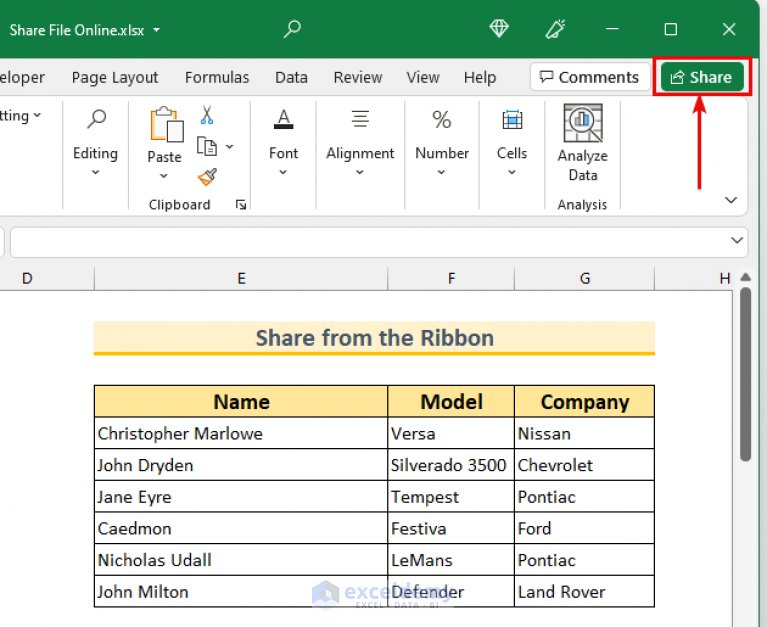5 Easy Ways to Share Your Excel Sheet

Sharing Excel spreadsheets can streamline collaboration, enhance productivity, and facilitate real-time data analysis among teams. In today's digital age, where remote work and teamwork are prevalent, mastering various methods to share an Excel sheet can give you an edge. This post will delve into five easy ways to share your Excel sheets, ensuring your team has seamless access to critical data, regardless of location or platform.
1. OneDrive and Excel Online

Using OneDrive, you can upload your Excel files to the cloud, allowing multiple users to edit or view the file concurrently. Here’s how:
- Save your Excel file to your local computer.
- Right-click on the file and select ‘Upload to OneDrive’ or click ‘OneDrive’ in the Excel app and save directly to cloud.
- Once the file is in OneDrive, click on the file, then click the ‘Share’ button on the top.
- Choose whether you want to grant edit or view-only permissions. Here you can also set expiration dates for links or require passwords.
💡 Note: Ensure your collaborators have an active OneDrive account to access and edit the shared Excel file.
2. Email Attachments

The traditional method of emailing Excel files as attachments remains a simple and effective way to share data:
- Open your Excel file and click ‘File’ > ‘Share’ then select ‘Email’.
- Choose ‘Send as Attachment’ to send the file directly from Excel or ‘Send a Copy’ if you want to control the version being shared.
- Compose your email, add recipients, and send the file.
This method is best for static data where real-time collaboration isn't necessary.
3. Dropbox or Google Drive

If you prefer cloud services outside of Microsoft’s ecosystem, Dropbox or Google Drive can be effective:
- Upload your Excel file to Dropbox or Google Drive.
- Right-click on the file or click the share icon to get a sharable link. You can set permissions (view, comment, or edit).
- Send the link to your collaborators.
💡 Note: Collaborators can edit documents directly if they have Google Sheets or equivalent capabilities. Excel files will open in an online viewer or editor.
4. SharePoint

If your organization uses SharePoint, it can be a powerful tool for document management and sharing:
- Navigate to your SharePoint site and go to the document library.
- Either upload your Excel file or create a new document directly within SharePoint.
- Click the file, choose ‘Share’, and grant permissions as required.
SharePoint integrates well with Microsoft Office, making document collaboration smooth and efficient.
5. Export as PDF

Not a traditional method for collaboration but highly useful for presenting data or sharing static information:
- Open your Excel sheet and go to ‘File’ > ‘Save As’.
- Choose ‘PDF’ from the file type options.
- Save the file and then share the PDF via email or other preferred methods.
This method ensures that the data is preserved in its current state, avoiding accidental changes during collaboration.
To wrap up, sharing your Excel sheets efficiently is crucial for modern business communication and teamwork. Whether you choose cloud solutions like OneDrive, Dropbox, or Google Drive for real-time collaboration, or opt for traditional methods like email attachments, each has its place in different workflows. The choice largely depends on your team's needs, the sensitivity of the data, and the level of collaboration required. Here are some key takeaways:
- Cloud Services offer real-time collaboration but require users to have an account.
- Email Attachments are straightforward but not ideal for ongoing collaboration.
- PDF Export is great for sharing static information or presentations.
By mastering these methods, you'll be able to share Excel sheets with ease, ensuring that all team members can work together efficiently and productively.
Can non-Microsoft users collaborate on OneDrive-shared Excel files?

+
Yes, non-Microsoft users can view or comment on OneDrive-shared Excel files. However, for editing, they would need to use Excel Online or have a Microsoft Office 365 subscription.
What are the limitations of sharing via email attachments?

+
Email attachments don’t allow for real-time collaboration. Large files can also exceed email size limits, and there’s no version control or track changes feature.
Is it possible to revoke access to a shared Excel file on cloud services?

+
Absolutely. On most cloud platforms, you can manage access permissions at any time, including revoking access or changing from edit to view-only for users.



